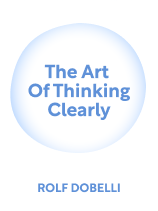

This article is an excerpt from the Shortform book guide to "The Art of Thinking Clearly" by Rolf Dobelli. Shortform has the world's best summaries and analyses of books you should be reading.
Like this article? Sign up for a free trial here .
What is cognitive dissonance? How do people resolve the uncomfortable feeling that arises as a result of dissonance between cognitions and actions?
In psychology, cognitive dissonance is the mental discomfort that occurs as a result of holding two conflicting cognitions (e.g. beliefs, values, or attitudes) or acting in ways that contradict those cognitions. To ease this discomfort, people tend to deny the facts or rationalize their thinking to restore cognitive consonance.
Keep reading to learn about the psychology of cognitive dissonance.
Cognitive Dissonance
In psychology, cognitive dissonance is the discomfort that occurs when your beliefs or desires conflict with your actions. To alleviate this cognitive discomfort, you deny or rationalize your actions until your memories of the situation change: You deny that you ever acted against your beliefs.
For example, if Ann believes stealing is wrong, but contradicts her beliefs by shoplifting, she’ll experience cognitive dissonance. Her brain will rationalize her actions to minimize the conflict or even change her memories so she forgets she ever shoplifted, depending on how severe the dissonance.
(Shortform note: Cognitive dissonance occurs because people have an innate desire for consistency: You want your decisions to be consistent with your beliefs. This is partly why changing your beliefs and worldview is so difficult, as it triggers cognitive dissonance. However, you can train yourself into new beliefs by consistently behaving in line with those new beliefs: As your new pattern of behavior is reinforced, cognitive dissonance will decrease.)
Falsification of History
When we experience cognitive dissonance about past events, we often (unconsciously) resort to falsification of history in an attempt to restore consonance: As your opinions and worldview change over time, your brain alters the details of your memories, making you remember the past in a way that better matches your current opinions and worldview.
(Shortform note: Your brain rewrites memories to be helpful: By updating the information, your memories become more relevant to the current moment and your current decisions. However, rewriting memories also means you become overconfident in your beliefs: When you think you’ve always held the same beliefs, you won’t feel the need to challenge them, and you’ll be skeptical of other people’s ability to change their own beliefs. On the other hand, if you remember how your beliefs have changed over time, you’ll be more open to adjusting them again and more welcoming to others who are challenging their beliefs.)
Even people’s strongest memories, usually made in joyous or traumatic situations, are dramatically altered as time goes by, Dobelli adds. (Shortform note: Many people believe these “flashbulb” moments remain untouched and are represented totally accurately in your memory. However, traumatic memories are often less accurate than other kinds of memories, not more accurate. Sometimes, traumatic memories are almost entirely fabricated because your ability to form memories is hampered in traumatic situations, not increased.)

———End of Preview———
Like what you just read? Read the rest of the world's best book summary and analysis of Rolf Dobelli's "The Art of Thinking Clearly" at Shortform .
Here's what you'll find in our full The Art of Thinking Clearly summary :
- A detailed look at the most common logical fallacies that inhibit decision-making
- How to recognize and overcome these fallacies to make better decisions
- Why you value things for arbitrary reasons






